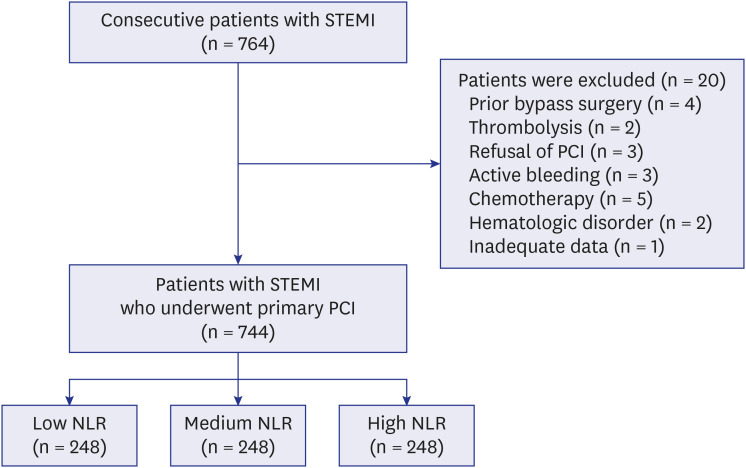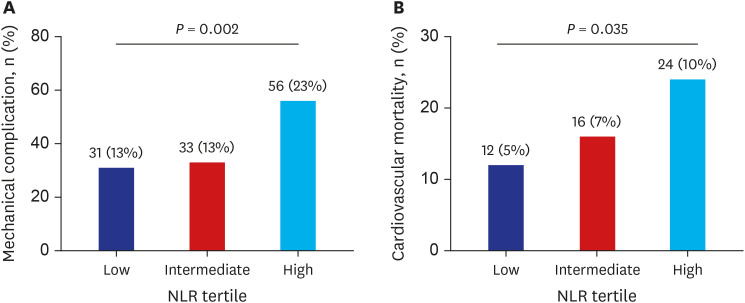J Korean Med Sci.
2021 May;36(19):e131. 10.3346/jkms.2021.36.e131.
Neutrophil-to-Lymphocyte Ratio at Emergency Room Predicts Mechanical Complications of ST-segment Elevation Myocardial Infarction
- Affiliations
-
- 1Division of Cardiology, Department of Internal Medicine, Cardiovascular Center, Seoul National University Bundang Hospital, Seongnam, Korea
- 2Division of Cardiology, Department of Internal Medicine, Inha University College of Medicine and Inha University Hospital, Incheon, Korea
- 3Division of Critical Care Medicine, Department of Hospital Medicine, Inha University Hospital, Incheon, Korea
- KMID: 2515866
- DOI: http://doi.org/10.3346/jkms.2021.36.e131
Abstract
- Background
The neutrophil-to-lymphocyte ratio (NLR) has been proven to be a reliable inflammatory marker. A recent study reported that elevated NLR is associated with adverse cardiovascular events in patients with ST-segment elevation myocardial infarction (STEMI). We investigated whether NLR at emergency room (ER) is associated with mechanical complications of STEMI undergoing primary percutaneous coronary intervention (PCI).
Methods
A total of 744 patients with STEMI who underwent successful primary PCI from 2009 to 2018 were enrolled in this study. Total and differential leukocyte counts were measured at ER. The NLR was calculated as the ratio of neutrophil count to lymphocyte count. Patients were divided into tertiles according to NLR. Mechanical complications of STEMI were defined by STEMI combined with sudden cardiac arrest, stent thrombosis, pericardial effusion, post myocardial infarction (MI) pericarditis, and post MI ventricular septal rupture, free-wall rupture, left ventricular thrombus, and acute mitral regurgitation during hospitalization.
Results
Patients in the high NLR group (> 4.90) had higher risk of mechanical complications of STEMI (P = 0.001) compared with those in the low and intermediate groups (13% vs. 13% vs. 23%). On multivariable analysis, NLR remained an independent predictor for mechanical complications of STEMI (RR = 1.947, 95% CI = 1.136–3.339, P= 0.015) along with symptom-to balloon time (P = 0.002) and left ventricular dysfunction (P < 0.001).
Conclusion
NLR at ER is an independent predictor of mechanical complications of STEMI undergoing primary PCI. STEMI patients with high NLR are at increased risk for complications during hospitalization, therefore, needs more intensive treatment after PCI.
Figure
Reference
-
1. Tamhane UU, Aneja S, Montgomery D, Rogers EK, Eagle KA, Gurm HS. Association between admission neutrophil to lymphocyte ratio and outcomes in patients with acute coronary syndrome. Am J Cardiol. 2008; 102(6):653–657. PMID: 18773982.
Article2. Kurtul A, Murat SN, Yarlioglues M, Duran M, Celik IE, Kilic A, et al. Increased neutrophil-to-lymphocyte ratio predicts persistent coronary no-flow after wire insertion in patients with ST-elevation myocardial infarction undergoing primary percutaneous coronary intervention. Clinics (Sao Paulo). 2015; 70(1):34–40. PMID: 25672427.
Article3. Chen C, Cong BL, Wang M, Abdullah M, Wang XL, Zhang YH, et al. Neutrophil to lymphocyte ratio as a predictor of myocardial damage and cardiac dysfunction in acute coronary syndrome patients. Integr Med Res. 2018; 7(2):192–199. PMID: 29984180.
Article4. Temiz A, Gazi E, Güngör Ö, Barutçu A, Altun B, Bekler A, et al. Platelet/lymphocyte ratio and risk of in-hospital mortality in patients with ST-elevated myocardial infarction. Med Sci Monit. 2014; 20:660–665. PMID: 24751474.
Article5. Arbel Y, Shacham Y, Ziv-Baran T, Laufer Perl M, Finkelstein A, Halkin A, et al. Higher neutrophil/lymphocyte ratio is related to lower ejection fraction and higher long-term all-cause mortality in ST-elevation myocardial infarction patients. Can J Cardiol. 2014; 30(10):1177–1182. PMID: 25154806.
Article6. Kaya MG, Akpek M, Lam YY, Yarlioglues M, Celik T, Gunebakmaz O, et al. Prognostic value of neutrophil/lymphocyte ratio in patients with ST-elevated myocardial infarction undergoing primary coronary intervention: a prospective, multicenter study. Int J Cardiol. 2013; 168(2):1154–1159. PMID: 23219132.
Article7. Zhang S, Diao J, Qi C, Jin J, Li L, Gao X, et al. Predictive value of neutrophil to lymphocyte ratio in patients with acute ST segment elevation myocardial infarction after percutaneous coronary intervention: a meta-analysis. BMC Cardiovasc Disord. 2018; 18(1):75. PMID: 29716535.
Article8. Park JJ, Jang HJ, Oh IY, Yoon CH, Suh JW, Cho YS, et al. Prognostic value of neutrophil to lymphocyte ratio in patients presenting with ST-elevation myocardial infarction undergoing primary percutaneous coronary intervention. Am J Cardiol. 2013; 111(5):636–642. PMID: 23273716.
Article9. Zuin M, Rigatelli G, Picariello C, dell’Avvocata F, Marcantoni L, Pastore G, et al. Correlation and prognostic role of neutrophil to lymphocyte ratio and SYNTAX score in patients with acute myocardial infarction treated with percutaneous coronary intervention: a six-year experience. Cardiovasc Revasc Med. 2017; 18(8):565–571. PMID: 28529092.
Article10. Sen N, Afsar B, Ozcan F, Buyukkaya E, Isleyen A, Akcay AB, et al. The neutrophil to lymphocyte ratio was associated with impaired myocardial perfusion and long term adverse outcome in patients with ST-elevated myocardial infarction undergoing primary coronary intervention. Atherosclerosis. 2013; 228(1):203–210. PMID: 23489347.
Article11. Duffy BK, Gurm HS, Rajagopal V, Gupta R, Ellis SG, Bhatt DL. Usefulness of an elevated neutrophil to lymphocyte ratio in predicting long-term mortality after percutaneous coronary intervention. Am J Cardiol. 2006; 97(7):993–996. PMID: 16563903.
Article12. Núñez J, Núñez E, Bodí V, Sanchis J, Miñana G, Mainar L, et al. Usefulness of the neutrophil to lymphocyte ratio in predicting long-term mortality in ST segment elevation myocardial infarction. Am J Cardiol. 2008; 101(6):747–752. PMID: 18328833.
Article13. Chia S, Nagurney JT, Brown DF, Raffel OC, Bamberg F, Senatore F, et al. Association of leukocyte and neutrophil counts with infarct size, left ventricular function and outcomes after percutaneous coronary intervention for ST-elevation myocardial infarction. Am J Cardiol. 2009; 103(3):333–337. PMID: 19166685.
Article14. Sawant AC, Adhikari P, Narra SR, Srivatsa SS, Mills PK, Srivatsa SS. Neutrophil to lymphocyte ratio predicts short- and long-term mortality following revascularization therapy for ST elevation myocardial infarction. Cardiol J. 2014; 21(5):500–508. PMID: 24142685.
Article15. Machado GP, Araujo GN, Carpes CK, Lech M, Mariani S, Valle FH, et al. Comparison of neutrophil-to-lymphocyte ratio and mean platelet volume in the prediction of adverse events after primary percutaneous coronary intervention in patients with ST-elevation myocardial infarction. Atherosclerosis. 2018; 274:212–217. PMID: 29803159.
Article16. Akpek M, Kaya MG, Lam YY, Sahin O, Elcik D, Celik T, et al. Relation of neutrophil/lymphocyte ratio to coronary flow to in-hospital major adverse cardiac events in patients with ST-elevated myocardial infarction undergoing primary coronary intervention. Am J Cardiol. 2012; 110(5):621–627. PMID: 22608360.
Article17. Habib SS, Kurdi MI, Al Aseri Z, Suriya MO. CRP levels are higher in patients with ST elevation than non-ST elevation acute coronary syndrome. Arq Bras Cardiol. 2011; 96(1):13–17. PMID: 21152699.18. Smit JJ, Ottervanger JP, Slingerland RJ, Kolkman JJ, Suryapranata H, Hoorntje JC, et al. Comparison of usefulness of C-reactive protein versus white blood cell count to predict outcome after primary percutaneous coronary intervention for ST elevation myocardial infarction. Am J Cardiol. 2008; 101(4):446–451. PMID: 18312755.
Article19. De Luca G, Suryapranata H, Zijlstra F, van't Hof AW, Hoorntje JC, Gosselink AT, et al. Symptom-onset-to-balloon time and mortality in patients with acute myocardial infarction treated by primary angioplasty. J Am Coll Cardiol. 2003; 42(6):991–997. PMID: 13678918.
Article20. Lee MJ, Park SD, Kwon SW, Woo SI, Lee MD, Shin SH, et al. Relation between neutrophil-to-lymphocyte ratio and index of microcirculatory resistance in patients with ST-segment elevation myocardial infarction undergoing primary percutaneous coronary intervention. Am J Cardiol. 2016; 118(9):1323–1328. PMID: 27600462.
Article21. Becker RC, Burns M, Gore JM, Spencer FA, Ball SP, French W, et al. Early assessment and in-hospital management of patients with acute myocardial infarction at increased risk for adverse outcomes: a nationwide perspective of current clinical practice. The National Registry of Myocardial Infarction (NRMI-2) Participants. Am Heart J. 1998; 135(5 Pt 1):786–796. PMID: 9588407.22. Cho KH, Jeong MH, Ahmed K, Hachinohe D, Choi HS, Chang SY, et al. Value of early risk stratification using hemoglobin level and neutrophil-to-lymphocyte ratio in patients with ST-elevation myocardial infarction undergoing primary percutaneous coronary intervention. Am J Cardiol. 2011; 107(6):849–856. PMID: 21247535.
Article
- Full Text Links
- Actions
-
Cited
- CITED
-
- Close
- Share
- Similar articles
-
- A Case of ST-Segment Elevation in a Patient with Subarachnoid Hemorrhage
- ST segment
- Impact of Right Ventricular Myocardial Involvement on Mortality and Morbidity during Percutaneous Coronary Intervention
- Acute Myocardial Infarction by Right Coronary Artery Occlusion Presenting as Precordial ST Elevation on Electrocardiography
- The Eletrocardiographic Analysis of Acute Myocardial Infarction and Non-infarction Syndrome In the Patients with ST Segment Elevation and Chest Pain



